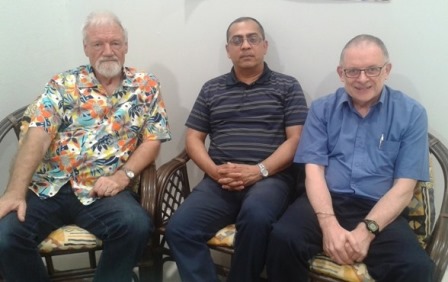
SUVA (University of the South Pacific / Pacific Media Watch): A New Zealand media academic has met with leaders of the University of the South Pacific's journalism programme and research office to discuss closer ties.
Professor Dr David Robie of Auckland University of Technology paid a courtesy visit to Deputy Vice-Chancellor Research and International, Professor Derrick Armstrong, to discuss possible areas of collaboration.
Professor Robie’s trip to USP was jointly sponsored by the USP Research Office and the Faculty of Arts Law and Education.
He was the keynote speaker at the 2015 USP Journalism Awards night last month, and he later delivered a seminar on optimising news media opportunities for academic research dissemination.
Professor Robie, together with Professor Armstrong, and the Head of USP Journalism, Dr Shailendra Singh, discussed potential areas of cooperation under the ambit of an existing USP-AUT memorandum of cooperation.
Professor Robie, the former coordinator of USP Journalism between 1998-2002, is now the director of AUT’s Pacific Media Centre. He expressed enthusiasm for stronger USP-AUT ties.
“As the senior journalism programme in the Pacific, USP has much in common with AUT’s school of journalism and communications, by far the largest of the 10 New Zealand journalism schools. There is plenty of potential for benchmarking and developing even more undergraduate and research collaborations in the future,” said Professor Robie.
Student exchanges between the AUT and USP journalism schools have already taken place over several years, as well as joint editorship of the AUT-based Pacific Journalism Review, the only research journal to investigate media issues in the South Pacific, Asia-Pacific, Australia and New Zealand.
Professor Armstrong said he welcomed any opportunities for closer ties and research collaborations with AUT.
His office is responsible for promoting a research culture among staff and students that encourage regional and international excellence to meet the expectations of USP’s member countries, and other stakeholders.
This work is licensed under a Creative Commons Attribution-NonCommercial 3.0 New Zealand Licence.




